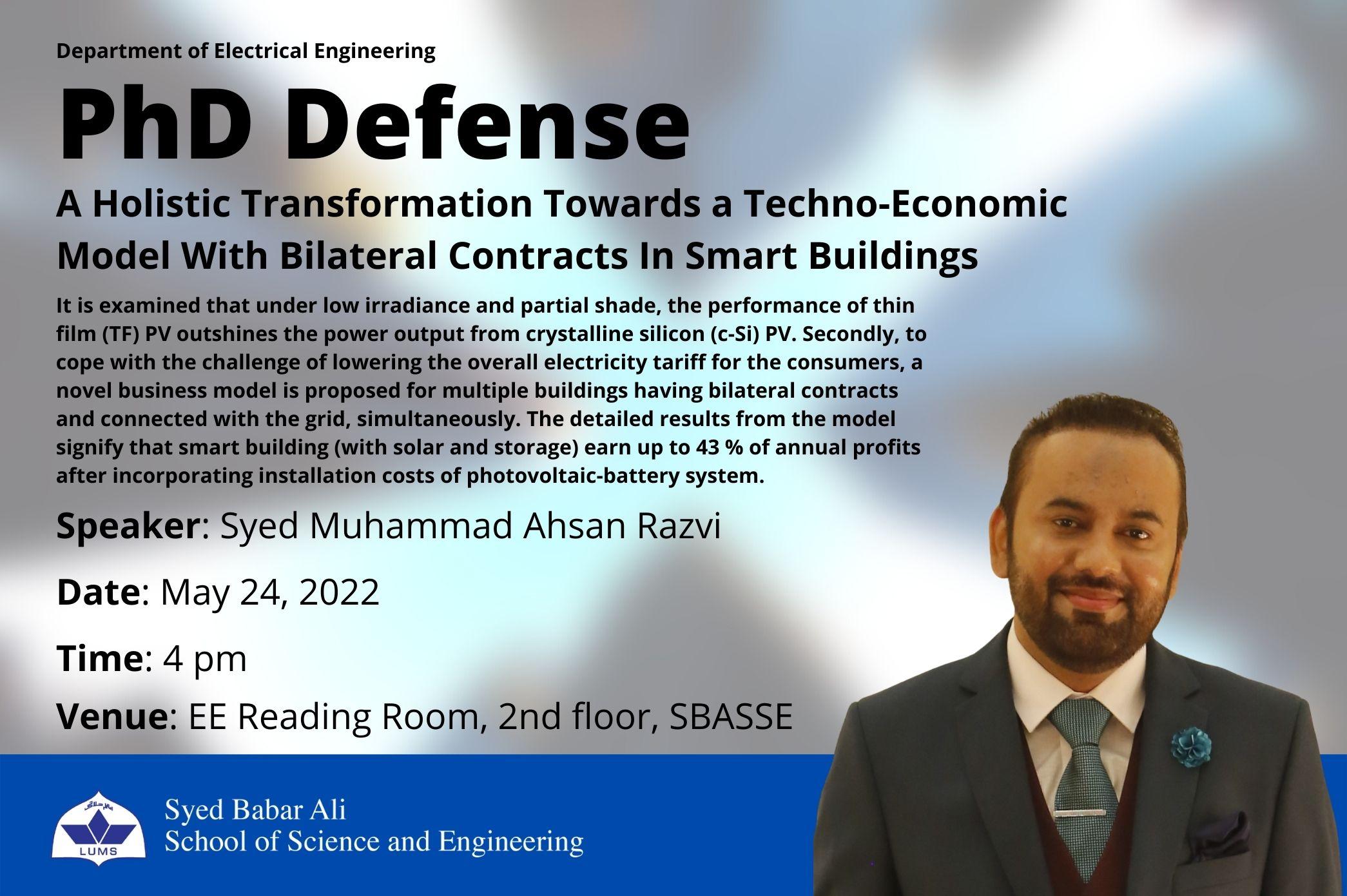
PhD Defence: A holistic transformation towards a Techno-Economic model with bilateral contracts in smart buildings
Firstly, it is examined that under low irradiance and partial shade, the performance of thin film (TF) PV outshines the power output from crystalline silicon (c-Si) PV. However, due to the relatively low efficiency of TF PV modules, larger rooftop area is required to extract similar amount of power compared to c-Si. Secondly, to cope with the challenge of lowering the overall electricity tariff for the consumers, a novel business model is proposed for multiple buildings having bilateral contracts and connected with the grid, simultaneously. The proposed business architecture caters for the profit margins of each participating building, whether it has rooftop solar PV or not. The detailed results from the model signify that smart building (with solar and storage) earn up to 43 % of annual profits after incorporating installation costs of photovoltaic-battery system. Further, secondary buildings (without solar or storage) achieve 3 - 16 % of savings in the electricity costs based on different contracted loads and agreement tariffs.
Thirdly, the integration of electric vehicles in smart buildings enables added options of electricity trade for the prosumer (smart building) along with the optimized charging of electric vehicles. It allows the smart building to earn up to 87 % profit and secondary buildings electricity cost saving goes up to 41 %. To further facilitate the charging station integration in smart buildings, vehicle-to-everything (V2X) concept is introduced. The optimized charging and discharging of electric vehicles in the parking station of smart building enables the fleet of electric vehicles to earn savings up to 66 %. In addition, primary building (smart building) earns profit up to 62 % whereas the electricity cost savings of secondary buildings ranges from 2- 20%. Lastly, the technical evaluation of rooftop grid-connected PV systems with high diffusion of non-linear loads facilitates the integration of rooftop solar PV as a distributed energy resource in the low voltage networks. The results reveal that the installation of solar PV at alternate buses allows to operate within the limits for total harmonic distortion in voltage and current. Overall, this thesis presents a detailed techno-economic model for smart building(s) having bilateral contracts with secondary buildings and charging infrastructure for electric vehicles, along with a detailed assessment of the power quality parameters for grid-connected rooftop solar PV in low voltage networks.
Final Thesis Defense Committee:
1. Dr. Asghar Saqib (Professor, External Evaluator)
Department of Electrical Engineering, University of Engineering and Technology (UET), Lahore, Pakistan.
2. Dr. Naveed-ul-Hassan (Associate Professor, Thesis Committee Member)
Syed Babar Ali School of Science and Engineering, Department of Electrical Engineering, Lahore University of Management Sciences (LUMS), Pakistan.
3. Prof. Nauman Ahmad Zaffar (Associate Professor, Thesis Committee Member)
Syed Babar Ali School of Science and Engineering, Department of Electrical Engineering, Lahore University of Management Sciences (LUMS), Pakistan.
4. Dr. Basit Shafiq (Associate Professor, Thesis Committee Member)
Syed Babar Ali School of Science and Engineering, Department of Computer Science, Lahore University of Management Sciences (LUMS), Pakistan.
5. Dr. Hassan Abbas Khan (Associate Professor, PhD Supervisor)
Syed Babar Ali School of Science and Engineering, Department of Electrical Engineering, Lahore University of Management Sciences (LUMS), Pakistan.
Publications:
- Ahsan, S., Niazi, K. A. K., Khan, H. A., & Yang, Y. (2018). Hotspots and performance evaluation of crystalline-silicon and thin-film photovoltaic modules. Microelectronics Reliability, 88, 1014-1018.
- Ahsan, S. M., & Khan, H. A. (2019). Performance comparison of CdTe thin film modules with c-Si modules under low irradiance. IET Renewable Power Generation, 13(11), 1920-1926.
- Ahsan, S. M., Khan, H. A., Hassan, N. U., Arif, S. M., & Lie, T. T. (2020). Optimized power dispatch for solar photovoltaic-storage system with multiple buildings in bilateral contracts. Applied Energy, 273, 115253.
- Baig, M. Q., Khan, H. A., & Ahsan, S. M. (2020). Evaluation of solar module equivalent models under real operating conditions—A review. Journal of Renewable and Sustainable Energy, 12(1), 012701.
- Arif, S. M., Lie, T. T., Seet, B. C., Ahsan, S. M., & Khan, H. A. (2020). Plug-In Electric Bus Depot Charging with PV and ESS and Their Impact on LV Feeder. Energies, 13(9), 2139.
- Arif, S. M., Hussain, A., Lie, T. T., Ahsan, S. M., & Khan, H. A. (2020). Analytical Hybrid Particle Swarm Optimization Algorithm for Optimal Siting and Sizing of Distributed Generation in Smart Grid. Journal of Modern Power Systems and Clean Energy, 8(6), 1221-1230.
- Ahsan, S. M., Khan, H. A., Ayyadi, S., Arif, S. M., & Lie, T. T. (2021, October). Optimized Power Dispatch for Solar-Storage System and Electric Vehicles with Multiple Buildings in Bilateral Contracts. In 2021 IEEE PES Innovative Smart Grid Technologies Europe (ISGT Europe) (pp. 1-5). IEEE.
- Ahsan, S. M., Khan, H. A., Hussain, A., Tariq, S., & Zaffar, N. A. (2021). Harmonic Analysis of Grid-Connected Solar PV Systems with Nonlinear Household Loads in Low-Voltage Distribution Networks. Sustainability, 13(7), 3709.
- Siraj, K., Ahsan, S. M., & Khan, H. A. (2021, June). Techno-economic Evaluation of Residential DC Power System for Multiple Distribution Voltages. In 2021 IEEE 48th Photovoltaic Specialists Conference (PVSC) (pp. 0858-0862). IEEE.
- S. M. Ahsan, and H. A. Khan, " LV Harmonic Analysis of Single-Phase Rooftop Solar PV Systems with Non-Linear Loads," (Accepted in IEEE Green Tech, USA, 2022)
- S. M. Ahsan, H. A. Khan, N.-u. Hassan, and S. Ayyadi," Optimized Power Dispatch for Smart Building(s) and Electric Vehicles with V2X Operation," (Submitted in Energy Reports)

